Please Take Note: This is a review of the final game, but it might change slightly based on the success of the Kickstarter campaign. The game is being reviewed on the components and the rules provided with the understanding that “what you see is not what you might get” when the game is published. If you like what you read and want to learn more, we encourage you to visit the Kickstarter campaign. Now that we have all that disclaimer junk out of the way, on with the review.
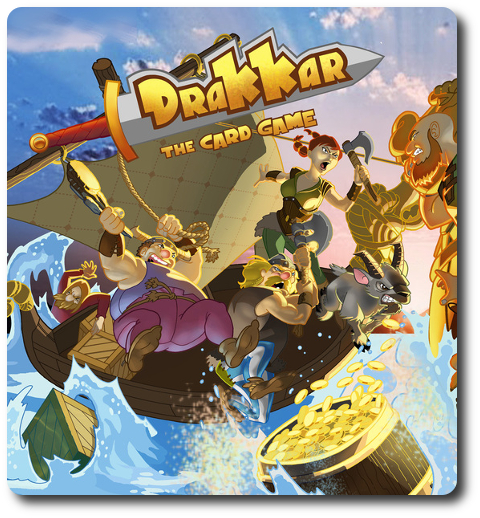
The Basics:
- For ages 10 and up (publisher suggests 12+)
- For 3 to 6 players
- Approximately 30 minutes to complete
Geek Skills:
- Active Listening & Communication
- Counting & Math
- Logical & Critical Decision Making
- Strategy & Tactics
- Hand/Resource Management
Learning Curve:
- Child – Easy
- Adult – Easy
Theme & Narrative:
- Vikings at their best and worst…
Endorsements:
- Gamer Geek mixed!
- Parent Geek approved!
- Child Geek approved!
Overview
On a small island is a group of competitive Viking villages. Each believes they embody the true Warrior Spirit and go out of their way to make sure their neighbors know it. In this game, you’ll lead your Viking village in various raid, pillaging loot, and then showing it off to impress others. The winner of the game is a true Viking and most likely a real nuisance to the local population.
Drakkar, designed by Jacopo Casiraghi, Mauro Monti, Gianni Negrini, Andrea Vitagliano and to be published by Spaceballoon Games, will reportedly be comprised of 50 double-sided cards (representing equipment, actions, and combat), 15 Quest cards, 60 Loot tokens, and 1 first player meeple. As this is a review of a prepublished game, I cannot comment on the game component quality.
Load the Boat!
To set up the game, first remove a certain number of cards from the game based on the number of players.
Second, separate the cards into two different piles. The first should only have the Quest cards. The second should have the equipment, actions, and combat cards. Shuffle each pile separately to create two different decks.
Second, deal each player one Quest card, face-down. Players should look at their cards, but keep them hidden from their opponents. Place the Quest deck in the middle of the playing area, face-down. Next to it, place the other deck of cards.
Third, divide the Loot tokens by type and organize into pools next to the Quest deck.
That’s it for game set up. Determine who will be the first player and give them the first player meeple. Let’s go pillage!
Set Sail!
Drakkar is played in rounds, phases, and turns. A typical game round is summarized here.
Phase 1: Brawl!
The current first player takes the double-sided cards, shuffles them (if necessary) and then divides them into even piles of ten cards each, one pile per player. All players should pay as close attention as possible in regards to what cards are going in each deck.
Then each player places one hand behind their back and one elbow on the table. The first player shouts “By Odin!” (or whatever you like). Each player then, as quickly as possible, places their index finger on the pile of cards of their choice. First player to touch the pile wins the pile. If an opponent beats a player to a pile, they must quickly choose another. Regardless, each player will have one pile of cards as their own.
Phase 2: Play Cards
Each player now collects their cards and puts them in their hand. They now select one to play, choosing which side is the “active” side. They place the “active” side face-up on the table in front of them, placing one hand over it so their opponents cannot see. This should be done as quickly as possible by all the players, as Vikings do not hesitate. The first player to place their card is considered the most fearsome and can count out loud to five, giving their opponents a set amount of time to play their card. Once everyone has played a card, they are revealed and resolved.
There are several different cards in the game. Each are summarized here.
The Red Banner cards are cheater cards and are resolved first. These cards allow the player to steal cards from opponents. For example, the “Loki” card allows a player to steal a Loot token from an opponent of their choice. Red Banner cards are resolved by their number value, starting with the lowest number.
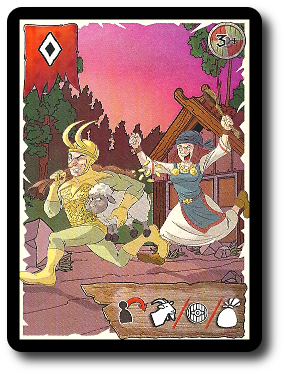
The Yellow Banner cards represent various pieces of equipment. For example, the ships, Viking warriors, barrels of beer, weapons (like Odin’s spear), and even some wood from the legendary Yggdrasil! These cards help the player complete quests. The Ship cards are used to build a ship that can be used to set sail on the ocean, raiding nearby settlements. A total of 3 Ship cards is necessary to build a big boat, or only two to create a boat of slightly less length. Ships “hold” other cards during the game, allowing players to crew their boats and load them with goods. For example, the Yellow Banner cards shown here create an entire Drakkar, which can store up to three other cards (one card per ship portion, but some cards don’t take up space). Only one boat can be built in front of a player at a time, but a player can always upgrade a Knarr (a boat comprised of a bow and stern) to a Drakkar.
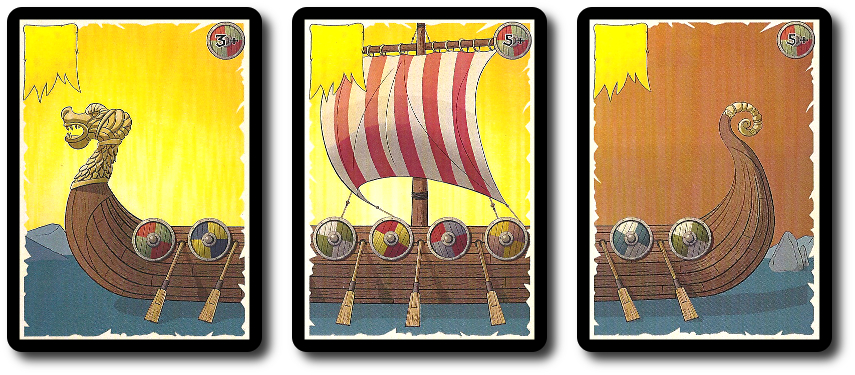
The Blue Banner cards are combat cards. Like the Red Banner cards, they are resolved one by one, starting with the lowest number first. Using the Blue Banner cards, players can attack their opponent’s forces by damaging their equipment and claiming Loot tokens. For example, the Blue Banner card shown here allows the player to force an opponent to discard a previously played “bow” of their ship, but only if that part of the ship.
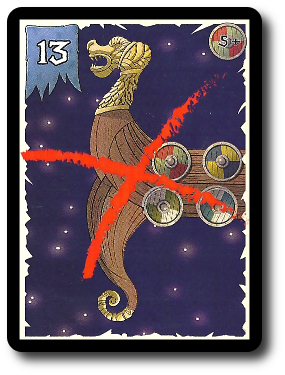
Phase 2 is repeated until all ten cards are played by each player. Once all the cards are played, the next phase begins.
Phase 3: Quest!
Each player was dealt a Quest card at the beginning of the game. Players now review their personal Quest card to determine if they have met their Quest requirements. A boat comprised of either two or three cards is required to go on missions. For example, if a player wants to complete the following quest, they will need to have built a boat, crew it with four Vikings, and stock it with one Beer. If they complete the quest, they stand to gain two Goods and two Goat Loot tokens.
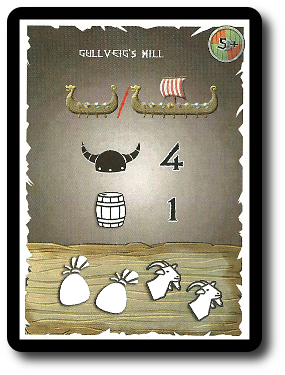
Players can ask other opponents for help, requesting missing items that are necessary to complete their Quest card. This is done as exchanges and are out in the open.
If a player determines they cannot complete their Quest this round, but do have a complete ship, they must openly sell their Vikings and Beer they have collected so far, thus assisting their opponents.
If the player completes the Quest by themselves, they reveal it and collect the noted Loot tokens at the bottom. If they had help, the player might have to pay a Loot token or two to the opponent who helped them. All collected Loot tokens are kept out in the open in front of their owning player.
Phase 4: Cleanup
After reviewing and resolving any Quest cards, all cards are collected and shuffled. This includes Quest cards that were not completed. The Quest cards are shuffled and a new Quest card is dealt to each player.
This ends the round.
Ending the Raid and Winning the Game
At the end of the third round, the game comes to an end. Players now calculate their scores, earning one point for every Loot token they have claimed and an additional point for each set of three Loot tokens of the same type. For example, a set of three Goat Loot tokens will earn the player four points (one point per token, plus one additional point for the set).
The player with the most points wins the game and is declared the most fearsome and successful leader of their Viking village.
To learn more about Drakkar, visit the Kickstarter campaign.
Final Word
 The Child Geeks had a great time with Drakkar, finding it entertaining and fun to attempt to complete their Quest, while at the same time doing their best to stop their opponents from succeeding. According to one Child Geek, “I like how fast the game is to play and how you keep really in the game from the first card to the last collected goat.” Another Child Geek said, “This is a game I would play with my family every night if I think I could win every night.” What the Child Geeks liked the most was how quickly the game was played. It always had an energy and a sense of focus that kept the Child Geeks engaged. When all the ships returned to the home villages, the Child Geeks unanimously agreed that Drakkar was a game they really enjoyed.
The Child Geeks had a great time with Drakkar, finding it entertaining and fun to attempt to complete their Quest, while at the same time doing their best to stop their opponents from succeeding. According to one Child Geek, “I like how fast the game is to play and how you keep really in the game from the first card to the last collected goat.” Another Child Geek said, “This is a game I would play with my family every night if I think I could win every night.” What the Child Geeks liked the most was how quickly the game was played. It always had an energy and a sense of focus that kept the Child Geeks engaged. When all the ships returned to the home villages, the Child Geeks unanimously agreed that Drakkar was a game they really enjoyed.
 The Parent Geeks also enjoy the game, finding it to be fun with their families and peers. The casual gamers were especially pleased with Drakkar. According to one such Parent Geek, “A fun game. I like how you have a new quest to complete each round and only three rounds to get as much loot as possible.” Some more experienced Parent Geeks found the game to be a bit too fast, wishing they had more than three rounds of game play to attempt to win, but they also suggested that ten cards per round was more than enough. As one Parent Geek put it, “You have ten cards per round to build a ship, supply it, man it, and go on a raid, but you still have enough time to mess with your opponents, too. I really like how the game lets you do it all, but with well-defined limits.” When the games were over, the Parent Geeks all agreed that Drakkar was a game they’d happily play again.
The Parent Geeks also enjoy the game, finding it to be fun with their families and peers. The casual gamers were especially pleased with Drakkar. According to one such Parent Geek, “A fun game. I like how you have a new quest to complete each round and only three rounds to get as much loot as possible.” Some more experienced Parent Geeks found the game to be a bit too fast, wishing they had more than three rounds of game play to attempt to win, but they also suggested that ten cards per round was more than enough. As one Parent Geek put it, “You have ten cards per round to build a ship, supply it, man it, and go on a raid, but you still have enough time to mess with your opponents, too. I really like how the game lets you do it all, but with well-defined limits.” When the games were over, the Parent Geeks all agreed that Drakkar was a game they’d happily play again.
 The Gamer Geeks found Drakkar to be an amusing filler game at best. At worst, a waste of their time. According to one Gamer Geek, “The game is just a bit too fast to really do much. It’s all about doing the best you can as fast as you can, which isn’t bad, but when you add in the ability to mess with your opponents, the game starts to get silly.” Another Gamer Geek said, “I think the game is a great filler, but not a game to be taken too seriously. Like all fillers, the game gets on the table quickly and entertains, but doesn’t really satisfy your gaming itch.” Gaming itch sounds like something you need a cream for, but the Gamer Geeks wanted Drakkar to be a bit more than what it was. This resulted in the Gamer Geeks giving the game a mixed endorsement.
The Gamer Geeks found Drakkar to be an amusing filler game at best. At worst, a waste of their time. According to one Gamer Geek, “The game is just a bit too fast to really do much. It’s all about doing the best you can as fast as you can, which isn’t bad, but when you add in the ability to mess with your opponents, the game starts to get silly.” Another Gamer Geek said, “I think the game is a great filler, but not a game to be taken too seriously. Like all fillers, the game gets on the table quickly and entertains, but doesn’t really satisfy your gaming itch.” Gaming itch sounds like something you need a cream for, but the Gamer Geeks wanted Drakkar to be a bit more than what it was. This resulted in the Gamer Geeks giving the game a mixed endorsement.
 Drakkar has a good mix of acting and reacting. Each card has two possibilities, essentially giving a player more choices than they know what to do with at the start of their game. The opening gambit is almost always focused on building a boat, as that is a necessary component to complete a Quest card. From there, a player must focus both on getting their own crew ready and making sure their opponents have problems preparing to set sail. This not-so-subtle game of building and espionage creates a lot of plays back and forth that are one part shoring up defenses and one part attacking the heck out of each other.
Drakkar has a good mix of acting and reacting. Each card has two possibilities, essentially giving a player more choices than they know what to do with at the start of their game. The opening gambit is almost always focused on building a boat, as that is a necessary component to complete a Quest card. From there, a player must focus both on getting their own crew ready and making sure their opponents have problems preparing to set sail. This not-so-subtle game of building and espionage creates a lot of plays back and forth that are one part shoring up defenses and one part attacking the heck out of each other.
While some thought that the game felt a bit too limited with only three rounds of game play, I found the game play length to be perfect. Drakkar stays on the table just long enough to make me feel like I played a solid game and is off the table quick enough to not overstay its welcome. The Gamer Geeks were absolutely right when they called this game a “filler”. It’s light, fast, and fun. Everything a filler should be.
Do play this game when you get a chance, especially if you are a casual player or have a family of gamers. Drakkar will impress you with its simplistic goals and card management difficulty. Do expect to be taken off course more than once as you react to negative cards, but it’s easy enough to set yourself back on the right track to victory. To win this game you need to roll with the punches and focus on the long game without getting to upset out short-term looses.
This is a paid for review of the game’s final prototype. Although our time and focus was financially compensated, our words are our own. We’d need at least 10 million dollars before we started saying what other people wanted. Such is the statuesque and legendary integrity of Father Geek which cannot be bought except by those who own their own private islands and small countries.



